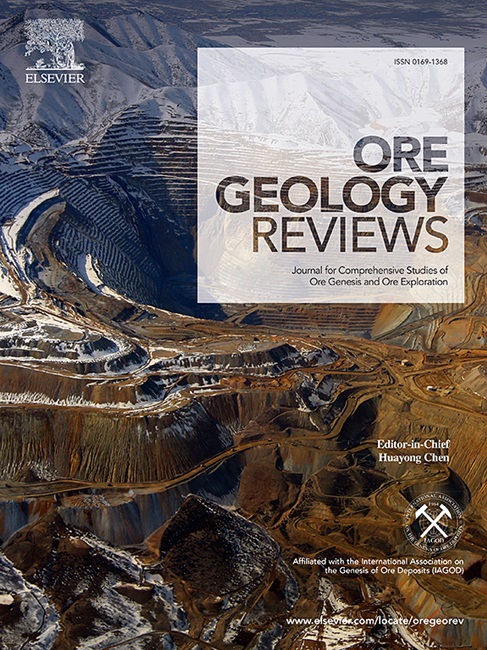胶东半岛辽上金矿床成矿流体特征及成因
IF 3.6
2区 地球科学
Q1 GEOLOGY
引用次数: 0
摘要
辽上金矿床位于胶莱盆地东北缘成矿区内。构造上位于胶莱盆地东北缘,胶莱盆地属于华北克拉通胶北地块。区域地层以古元古代景山群和新生代第四纪为主。辽上金矿床的成矿作用分为三个阶段:Ⅰ:黄铁矿-白云岩阶段;Ⅱ:金-多金属硫化物-白云岩阶段;Ⅲ:石英白云岩阶段。白云岩是主要的含金矿物之一。为明确成矿流体和成矿物质的来源和性质,探索成矿过程,揭示矿床成因,对主成矿阶段含金白云岩中的流体包裹体进行了岩相观察、显微测温分析和激光拉曼光谱分析,并对含金白云岩进行了C-O同位素分析。流体包裹体研究表明,辽上金矿主成矿期成矿流体属于CO2-H2O- nacl流体体系,具有中温(238 ~ 321℃)、低矿化度(3.71 ~ 10.33 wt%)、低密度(0.45 ~ 0.62 g/cm3)、高CO2、高H2O含量的特征。主成矿期含金白云岩的C-O同位素分析结果显示,白云岩的δ13CV-PDB值为−2.3 ~−4.1‰,δ18OV-SMOW值为8.8 ~ 10.7‰,成矿流体主要来源于岩浆源或深部岩浆流体。综合分析认为,辽上金矿床的成矿过程如下:早白垩世,在太平洋板块的俯冲作用下,区域由挤压应力场向伸展应力场过渡。软流层物质上升并分化演化;多源混合成矿流体伴随岩浆活动,沿早期断裂构造向上运移、充填、结晶。这些流体将景山群的部分成矿物质浸出,在盆地边缘拆离构造处富集沉淀,最终形成辽商型黄铁矿-碳酸盐脉状金矿床。本文章由计算机程序翻译,如有差异,请以英文原文为准。

Ore-forming fluid characteristics and genesis of the Liaoshang gold deposit, Jiaodong Peninsula
The Liaoshang gold deposit is situated in the mineralized district on the northeastern margin of the Jiaolai Basin. Tectonically, it lies within the northeast margin of the Jiaolai Basin, which is part of the Jiaobei Block in the North China Craton. Regional strata are dominated by the Paleoproterozoic Jingshan Group and the Cenozoic Quaternary. The mineralization of the Liaoshang gold deposit is divided into three stages: Ⅰ: pyrite-dolomite stage; Ⅱ: gold-polymetallic sulfide-dolomite stage; Ⅲ: quartz-dolomite stage. Dolomite is one of the primary gold-bearing minerals. To clarify the sources and properties of ore-forming fluids and materials, explore the mineralization process, and reveal the deposit genesis, this study conducted petrographic observations, microthermometric analyses, and laser Raman spectroscopy of fluid inclusions in gold-bearing dolomite from the main mineralization stage, along with C-O isotope analyses of gold-bearing dolomite. Fluid inclusion studies indicate that the ore-forming fluids during the main mineralization stage of the Liaoshang gold deposit belong to a CO2-H2O-NaCl fluid system, characterized by medium temperature (238–321℃), low salinity (3.71–10.33 wt%), low density (0.45–0.62 g/cm3), and high contents of CO2 and H2O. C-O isotope analyses of gold-bearing dolomite from the main mineralization stage yield δ13CV-PDB values of −2.3 to −4.1 ‰ and δ18OV-SMOW values of 8.8 to 10.7 ‰ for dolomite, suggesting that the ore-forming fluids were primarily derived from magmatic sources or deep-seated magmatic fluids. Comprehensive analysis indicates the mineralization process of the Liaoshang gold deposit as follows: During the Early Cretaceous, under the subduction of the Pacific Plate, the region transitioned from a compressional stress field to an extensional stress field. Asthenospheric materials ascended and underwent differentiation and evolution; multi-source mixed ore-forming fluids, accompanying magmatic activity, migrated upward, filled, and crystallized along early-formed fault structures. These fluids leached part of the ore-forming materials from the Jingshan Group, then enriched and precipitated at detachment structures on the basin margin, ultimately forming the Liaoshang-type pyrite-carbonate vein-type gold deposit.
求助全文
通过发布文献求助,成功后即可免费获取论文全文。
去求助
来源期刊

Ore Geology Reviews
地学-地质学
CiteScore
6.50
自引率
27.30%
发文量
546
审稿时长
22.9 weeks
期刊介绍:
Ore Geology Reviews aims to familiarize all earth scientists with recent advances in a number of interconnected disciplines related to the study of, and search for, ore deposits. The reviews range from brief to longer contributions, but the journal preferentially publishes manuscripts that fill the niche between the commonly shorter journal articles and the comprehensive book coverages, and thus has a special appeal to many authors and readers.
 求助内容:
求助内容: 应助结果提醒方式:
应助结果提醒方式:


